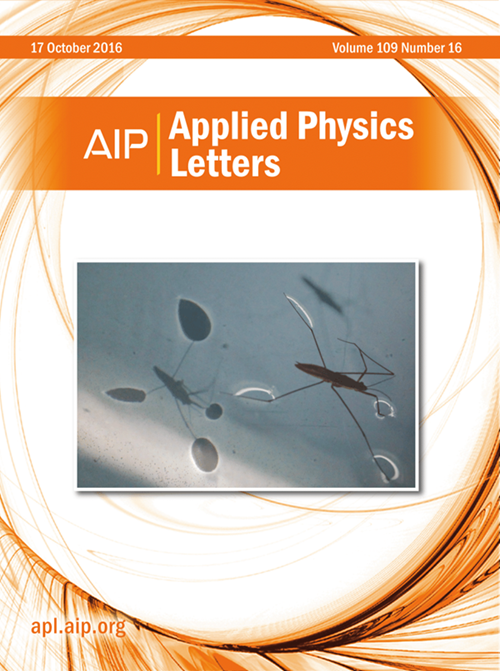High-sensitivity GaN UV photodetector integrated with graphene
IF 3.6
2区 物理与天体物理
Q2 PHYSICS, APPLIED
引用次数: 0
Abstract
Ultraviolet (UV) photodetectors are critical for a wide range of applications, where high sensitivity and low dark current are essential for accurate detection. This study presents a graphene-based p-i-n UV photodetector with a Gr/i-GaN/n-GaN structure, aimed at improving UV detection performance by improving sensitivity and reducing dark current. Graphene, as a p-type material, enhances carrier mobility and reduces recombination, while leveraging the wide bandgap properties of i-GaN and n-GaN for efficient UV absorption. The experimental results show that the graphene/i-GaN/n-GaN photodetector achieves a maximum photoresponsivity of 20.6 A/W, detectivity of 2.0 × 1012 cm·Hz1/2·W−1, and external quantum efficiency of 75.25%, indicating efficient light-to-current conversion performance. The integration of graphene in the p-i-n structure significantly reduces the dark current to 2.68 × 10−13 A, improving both the transient response and the overall efficiency of the device. These findings underscore the effectiveness of the graphene/i-GaN/n-GaN structure in improving UV photodetection performance. By combining the high mobility of graphene and the wide bandgap properties of GaN, this work demonstrates potential for application in graphene-based p-i-n photodetectors as a viable approach for future UV sensing applications, offering enhanced performance and stability for precise UV detection across varying conditions.集成石墨烯的高灵敏度GaN紫外光电探测器
紫外(UV)光电探测器对于广泛的应用至关重要,其中高灵敏度和低暗电流对于准确检测至关重要。本研究提出了一种Gr/i-GaN/n-GaN结构的石墨烯基p-i-n紫外光电探测器,旨在通过提高灵敏度和降低暗电流来提高紫外探测性能。石墨烯作为p型材料,增强了载流子迁移率,减少了复合,同时利用了i-GaN和n-GaN的宽带隙特性来有效吸收紫外线。实验结果表明,石墨烯/i-GaN/n-GaN光电探测器的最大光响应率为20.6 a /W,探测率为2.0 × 1012 cm·Hz1/2·W−1,外量子效率为75.25%,具有高效的光电流转换性能。石墨烯在p-i-n结构中的集成显著降低了暗电流至2.68 × 10−13 A,提高了器件的瞬态响应和整体效率。这些发现强调了石墨烯/i-GaN/n-GaN结构在提高紫外光探测性能方面的有效性。通过结合石墨烯的高迁移率和GaN的宽带隙特性,这项工作证明了石墨烯基p-i-n光电探测器作为未来紫外传感应用的可行方法的应用潜力,为不同条件下的精确紫外检测提供了更高的性能和稳定性。
本文章由计算机程序翻译,如有差异,请以英文原文为准。
求助全文
约1分钟内获得全文
求助全文
来源期刊

Applied Physics Letters
物理-物理:应用
CiteScore
6.40
自引率
10.00%
发文量
1821
审稿时长
1.6 months
期刊介绍:
Applied Physics Letters (APL) features concise, up-to-date reports on significant new findings in applied physics. Emphasizing rapid dissemination of key data and new physical insights, APL offers prompt publication of new experimental and theoretical papers reporting applications of physics phenomena to all branches of science, engineering, and modern technology.
In addition to regular articles, the journal also publishes invited Fast Track, Perspectives, and in-depth Editorials which report on cutting-edge areas in applied physics.
APL Perspectives are forward-looking invited letters which highlight recent developments or discoveries. Emphasis is placed on very recent developments, potentially disruptive technologies, open questions and possible solutions. They also include a mini-roadmap detailing where the community should direct efforts in order for the phenomena to be viable for application and the challenges associated with meeting that performance threshold. Perspectives are characterized by personal viewpoints and opinions of recognized experts in the field.
Fast Track articles are invited original research articles that report results that are particularly novel and important or provide a significant advancement in an emerging field. Because of the urgency and scientific importance of the work, the peer review process is accelerated. If, during the review process, it becomes apparent that the paper does not meet the Fast Track criterion, it is returned to a normal track.
 求助内容:
求助内容: 应助结果提醒方式:
应助结果提醒方式:


